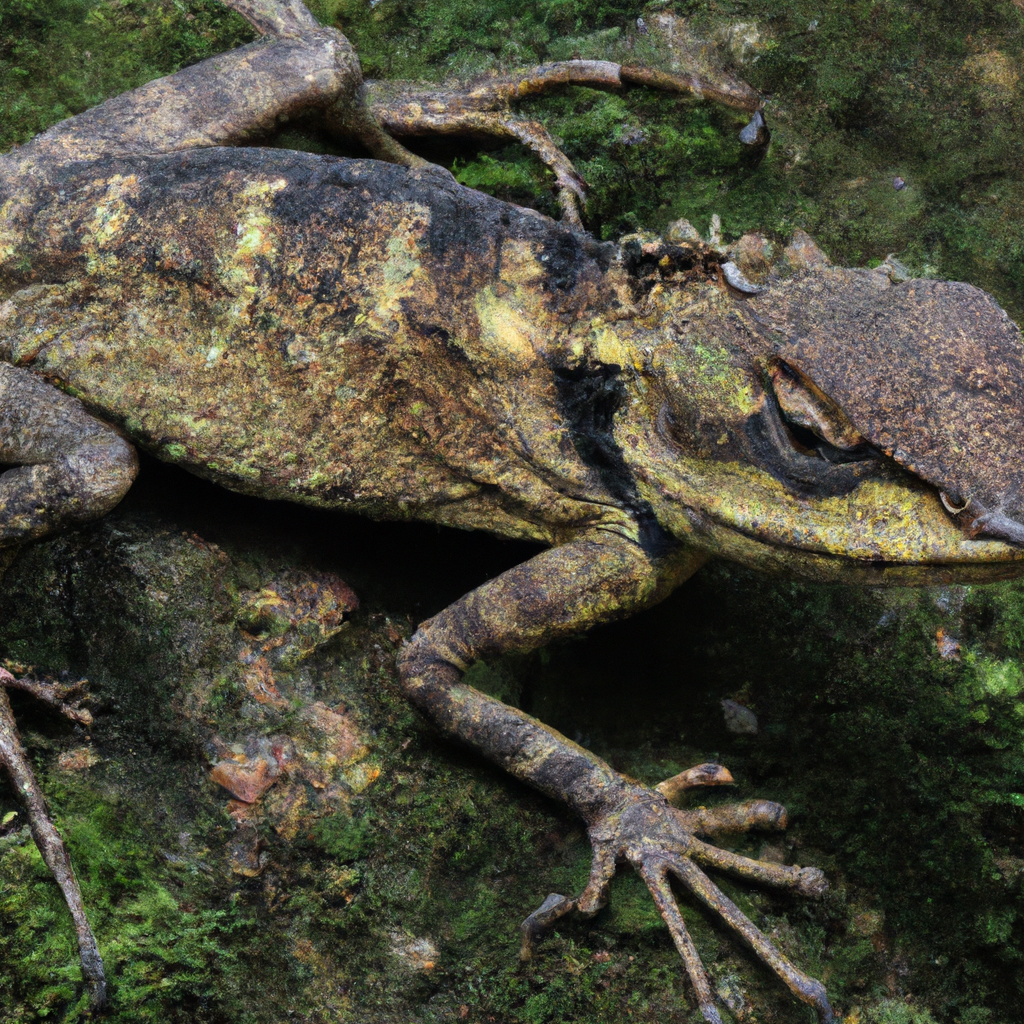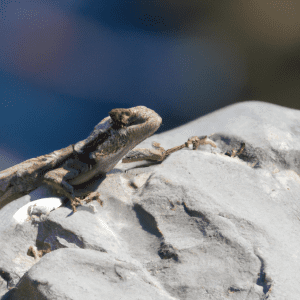Introduction to Himalayan Lizards
Imagine you’re a Himalayan lizard, just minding your own business, soaking up the sun on a rocky ledge. Suddenly, the weather takes a turn, and a blizzard hits the region. Yikes! Talk about an unexpected cold snap! But fear not, our scaly friends have some pretty cool tricks up their sleeves to deal with such extreme conditions.
Himalayan lizards are like the ultimate survival experts of the reptile world. They’ve got this whole adaptation thing down to a science. From their unique skin patterns that help them blend into their rocky surroundings to their ability to regulate their body temperature like a boss, these lizards are basically the James Bonds of the lizard kingdom.
Now, picture this – a Himalayan lizard doing yoga on a frosty morning, striking a pose that would put even the most seasoned yogi to shame. These little guys know how to stay limber and agile, ready to dart away at a moment’s notice if a predator decides to crash their morning meditation session.
But it’s not all fun and games for these cold-blooded creatures. They face some serious challenges in their high-altitude habitat, where the weather can be as unpredictable as your grandma’s cooking. Yet, through millions of years of evolution, Himalayan lizards have developed some pretty nifty adaptations that help them thrive in this harsh environment.
So, next time you’re out hiking in the Himalayas, keep an eye out for these amazing little reptiles. They may be small, but they’ve got big personalities and even bigger survival skills. And who knows, you might just learn a thing or two from these frosty weather warriors.
Climate Challenges in the Himalayan Region
Let’s delve into the fascinating topic of climate challenges in the Himalayan region. Picture this: you’re standing amidst the majestic Himalayan mountains, marveling at their beauty. But beneath this awe-inspiring exterior lies a harsh reality for the creatures that call this region home, including the resilient Himalayan lizards.
The Himalayas present a unique set of challenges when it comes to climate. From the towering peaks to the deep valleys, the terrain varies drastically, leading to diverse microclimates within a relatively small geographic area. This variability means that Himalayan lizards must adapt not only to extreme temperatures but also to rapid changes in weather conditions.
One interesting fact about the Himalayan region is its role as the “Third Pole” due to its vast ice fields and glaciers. These icy landscapes have a significant impact on the climate patterns in the region, influencing everything from temperature to precipitation. Imagine the Himalayan lizards navigating this icy terrain and finding ways to thrive despite the harsh conditions.
The challenge of climate adaptation is not just limited to Himalayan lizards; it extends to all species living in this fragile ecosystem. As temperatures rise and habitats shift, these creatures must constantly evolve to survive. How do Himalayan lizards cope with the changing climate, and what can we learn from their adaptations?
As we explore the climate challenges faced by Himalayan lizards, it raises a thought-provoking question: How can we ensure the preservation of these remarkable creatures and their habitats in the face of climate change? Understanding the intricacies of their adaptations is not only a scientific endeavor but also a critical step towards conservation and sustainability in the Himalayan region.
So, next time you gaze upon the breathtaking Himalayan landscape, take a moment to appreciate the resilience of the Himalayan lizards and the remarkable adaptations that allow them to thrive in one of the world’s most challenging environments.
Importance of Adaptations for Survival
Hey, did you know that when it comes to understanding the adaptations of Himalayan lizards to their challenging climate, it’s like unraveling a fascinating puzzle? These little reptiles have some incredible tricks up their sleeves to survive in such extreme conditions. Imagine trying to thrive in an environment where the temperature can fluctuate drastically from day to night – it’s no easy feat!
The importance of adaptations for survival in the Himalayan region is truly remarkable. These lizards have evolved over time to develop unique physical, behavioral, and physiological strategies that allow them to not just survive, but thrive in this harsh environment. It’s like they have their own superhero powers that help them combat the challenges thrown at them by Mother Nature.
From their ability to change color to blend in with their surroundings to their specialized diets that provide them with the necessary nutrients to stay healthy, every aspect of their adaptation is a marvel to behold. And let’s not forget about their behavioral adaptations – from basking in the sun to regulate their body temperature to seeking shelter in rocky crevices during harsh weather, these lizards have mastered the art of survival.
So, the next time you see a Himalayan lizard scurrying around, take a moment to appreciate the incredible adaptations that enable them to call this challenging environment home. It’s a testament to the resilience and ingenuity of these little creatures, showing us just how amazing the natural world can be.
Physical Adaptations of Himalayan Lizards
Let me tell you about the physical adaptations of Himalayan lizards – it’s truly fascinating! These little creatures have evolved some incredible features to survive in such harsh climates. Did you know that their scales play a crucial role in regulating their body temperature? It’s like having a built-in thermostat!
Imagine this – I once saw a Himalayan lizard basking in the sun, and its scales seemed to shimmer like tiny solar panels. That’s because these scales are not just for protection; they also help absorb sunlight to warm up their bodies in the cold Himalayan environment. It’s like they have their own little solar power system!
Now, here’s an interesting fact for you: Himalayan lizards have specialized skin that can change color to match their surroundings. This incredible camouflage not only helps them blend in with the rocky terrain but also allows them to avoid predators. It’s like they’re playing an ongoing game of hide-and-seek with their enemies!
Just picture this: a tiny lizard perfectly blending into the rocky landscape, almost disappearing from sight. It’s like nature’s own disappearing act! This adaptive camouflage is a crucial survival strategy for these lizards in the harsh Himalayan climate.
So, next time you see a Himalayan lizard, take a moment to appreciate the remarkable physical adaptations that allow these creatures to thrive in such challenging conditions. Their unique features are a testament to the wonders of evolution and the resilience of life in the face of adversity.
Behavioral Adaptations for Climate Resilience
Have you ever wondered how Himalayan lizards manage to thrive in such extreme climates? It’s truly fascinating to learn about the behavioral adaptations these remarkable creatures have developed over time. Did you know that Himalayan lizards exhibit unique sunbathing behaviors to regulate their body temperature in the cold mountainous regions? These lizards can often be seen basking in the sun on rocks or tree branches, absorbing the warmth to maintain their internal temperature within a suitable range.
This sunbathing ritual is not just a leisurely activity for these lizards; it is a crucial survival strategy. By exposing themselves to the sun’s rays, they can increase their body temperature and remain active even in the chilly Himalayan environment. This behavior helps them optimize their metabolic processes and ensure they have enough energy to hunt for food and carry out other essential activities.
The ability of Himalayan lizards to adapt their behavior to the challenging climate conditions highlights the incredible resilience of these creatures. Their capacity to adjust their daily routines to the environmental constraints they face is a testament to the evolutionary wonders of nature. Observing these lizards in their natural habitat, engaging in their sunbathing rituals, offers a glimpse into the intricate ways in which wildlife has evolved to survive and thrive in diverse ecosystems.
Next time you come across a Himalayan lizard soaking up the sun’s warmth, take a moment to appreciate the ingenuity behind this seemingly simple act. It’s a reminder of the remarkable adaptations that exist in the natural world and the endless wonders waiting to be discovered in the animal kingdom.
Physiological Strategies for Coping with Extreme Conditions
You know, when we delve into the physiological strategies that Himalayan lizards have developed to cope with extreme conditions, it’s truly fascinating. Did you know that these resilient creatures have the ability to adjust their metabolism based on the temperature around them? It’s like they have an internal thermostat that allows them to regulate their energy expenditure to adapt to the cold Himalayan climate.
This metabolic flexibility is crucial for their survival in such harsh environments. By being able to slow down their metabolism when temperatures drop, Himalayan lizards conserve energy and maintain their bodily functions even in freezing conditions. Conversely, when the temperature rises, they can ramp up their metabolism to stay active and alert.
This incredible adaptation showcases the remarkable evolutionary journey that these lizards have undergone to thrive in the Himalayas. It makes you wonder about the intricate mechanisms at play within their bodies and how they have fine-tuned their physiological responses over generations to tackle the challenges of their surroundings.
Understanding these physiological strategies not only sheds light on the resilience of Himalayan lizards but also provides valuable insights into the broader field of evolutionary biology. It prompts us to marvel at the wonders of nature and the incredible ways in which living organisms have adapted to diverse and demanding environments.
So, the next time you see a Himalayan lizard basking in the sun or braving the cold mountain winds, take a moment to appreciate the intricate biological processes that enable them to thrive in the face of adversity. It’s a testament to the power of adaptation and survival in the natural world, reminding us of the endless wonders waiting to be discovered in the fascinating realm of evolutionary science.
Evolutionary Insights into Adaptations
**9. Consider the broader implications or significance of VII.**
You know, understanding the evolutionary insights into adaptations of Himalayan lizards can actually have some pretty significant implications beyond just these fascinating reptiles. When we delve into the ways in which these lizards have evolved to survive in such extreme environments, it provides us with valuable knowledge about the process of adaptation itself.
Think about it – by studying the genetic changes, physical traits, and behavioral strategies that have allowed Himalayan lizards to thrive in their challenging habitat, scientists gain a deeper understanding of how organisms can adjust to environmental changes over time. This knowledge can be applied to other species facing similar challenges due to climate change or habitat loss.
By unraveling the evolutionary mechanisms that have shaped the adaptations of these lizards, researchers can also gain insights into broader ecological principles. For instance, studying how these reptiles interact with their environment and how their adaptations influence their ecosystem can offer valuable lessons in conservation and biodiversity management.
Moreover, the adaptations of Himalayan lizards serve as a testament to the incredible diversity and resilience of life on our planet. They remind us of the intricate ways in which organisms have evolved to survive and thrive in even the harshest of conditions. Understanding and appreciating these adaptations can foster a greater sense of connection to the natural world and inspire us to protect and preserve the rich tapestry of life that surrounds us.
So, next time you come across a Himalayan lizard basking in the sun or scurrying across a rocky slope, take a moment to marvel at the wonders of adaptation and consider the profound implications that these tiny creatures hold for our understanding of the world around us.
Interactions with the Himalayan Ecosystem
You know, when we dive into the interactions that Himalayan lizards have with their ecosystem, it’s like uncovering a hidden treasure trove of fascinating facts and discoveries. One interesting tidbit that might surprise you is the symbiotic relationships these lizards have with other species in their environment. It’s like they’re part of this intricate web of connections and dependencies that all contribute to the delicate balance of the ecosystem.
Imagine this – some Himalayan lizards have developed specialized behaviors that benefit not only themselves but also other organisms around them. For instance, certain species of lizards might serve as hosts for parasites that, in turn, help control the population of harmful insects in the area. It’s a mutually beneficial arrangement that showcases the complexity and interconnectedness of nature.
Exploring these symbiotic relationships can offer us a deeper understanding of how every creature, no matter how small, plays a vital role in maintaining the biodiversity of the Himalayan ecosystem. It highlights the intricate dance of nature where each participant, including our scaly friends, contributes to the overall harmony of the environment.
So, the next time you spot a Himalayan lizard basking in the sun or scurrying across the rocks, remember that there’s more to their presence than meets the eye. They are not just solitary creatures navigating their environment but active participants in a larger ecological narrative that we are only just beginning to unravel. And who knows, the more we delve into their world, the more surprises and wonders we might uncover along the way.
Conservation Implications of Adaptations
You know, when we talk about the adaptations of Himalayan lizards, it’s not just about these fascinating creatures surviving in extreme environments. There’s actually a much broader significance to their adaptations that goes beyond just their own well-being. These adaptations offer us valuable insights into the natural world and the delicate balance of ecosystems.
Think about it – the fact that these lizards have evolved specific traits to thrive in the harsh Himalayan climate tells us a lot about the interconnectedness of living organisms and their environments. By studying these adaptations, scientists can gain a deeper understanding of how species respond to environmental changes and how they can potentially adapt to future challenges, such as climate change.
The adaptations of Himalayan lizards also have implications for conservation efforts. Understanding how these creatures have evolved to survive can help us develop better conservation strategies to protect not only the lizards themselves but also the entire ecosystem they are a part of. By preserving their habitat and ensuring their survival, we are not just safeguarding a single species but also contributing to the overall health and biodiversity of the region.
Moreover, these adaptations serve as a reminder of the incredible diversity and resilience of life on our planet. The ability of Himalayan lizards to adapt and thrive in such extreme conditions is a testament to the amazing capabilities of nature. It inspires us to appreciate and protect the rich tapestry of life that surrounds us, highlighting the importance of conservation and sustainability in safeguarding our natural world for future generations.
So, the next time you come across a story about the adaptations of Himalayan lizards, remember that it’s not just about reptiles surviving in the mountains – it’s about the intricate web of life and the lessons it has to teach us about our place in the world.
The Resilience of Himalayan Lizards
Let me tell you about the physical adaptations of Himalayan lizards that help them thrive in their challenging environment. These creatures have some fascinating features that allow them to withstand the harsh conditions of the Himalayan region.
Did you know that Himalayan lizards have developed unique physical characteristics to adapt to the extreme climate of their habitat? One interesting fact is that their scales have evolved to help regulate their body temperature in the cold mountainous terrain. This allows them to bask in the sun to warm up and retreat to cooler areas to avoid overheating.
These lizards are true masters of survival, and their physical adaptations play a crucial role in their ability to thrive in such a demanding environment. From their specialized skin patterns that provide camouflage against predators to their streamlined bodies that aid in maneuvering through rocky terrains, every aspect of their physical features has a purpose.
Now, imagine a lizard blending seamlessly into the rocky surroundings, almost invisible to the naked eye. It’s like a natural form of camouflage that not only helps them hide from predators but also allows them to ambush their prey effectively. Their physical adaptations have been honed through years of evolution, making them perfectly suited to their mountainous home.
As we delve deeper into the world of Himalayan lizards, it’s truly remarkable to consider the intricate ways in which they have adapted to survive in such a challenging environment. These creatures are a testament to the power of evolution and the incredible diversity of life on our planet.
So, the next time you come across a Himalayan lizard, take a moment to appreciate the remarkable physical adaptations that enable them to thrive in one of the harshest environments on Earth.




